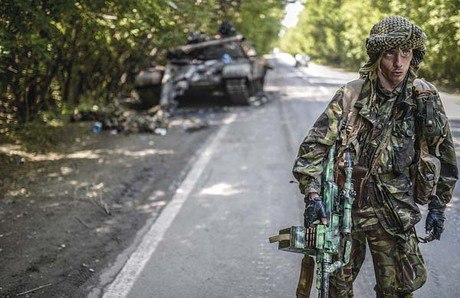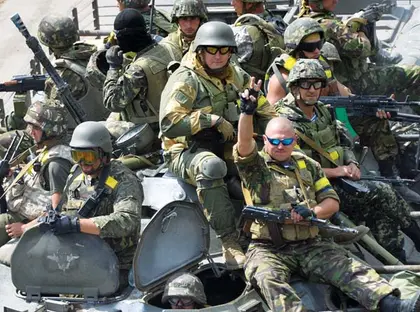Using everything from small arms and mortars to heavy artillery and airstrikes, they have managed to retake some key cities in Donetsk and Luhansk oblasts, home to 15 percent of Ukraine’s population, forcing the insurgents to retreat to provincial capitals and their outskirts.
The military is closer than ever to fully encircling the rebels. But the wins have come at a steep cost. Hundreds of civilians have been killed since the government launched its anti-terrorist operation in mid-April.
JOIN US ON TELEGRAM
Follow our coverage of the war on the @Kyivpost_official.
In the past week alone, there have been dozens more casualties as well as heavy damage to residential buildings and infrastructure. The military also lost two more warplanes this week, shot down at an altitude of 5,200 meters by what Kyiv authorities say were rockets fired from Russian territory. Brought down near Savur-Mohyla and Dmytrivka, their shooting-down brought the total number of aircraft downed or damaged since the start of the conflict to nearly 20.
Kremlin-backed guerillas also continue to control a strategic border crossing near Izvaryye in Luhansk Oblast, which they use to transport weapons and reinforcements from Russia into Ukraine, according to Kyiv and Western intelligence sources.
Gains in Donetsk Oblast
In the past week, government forces have continued to bombard rebel positions in the village of Marinka on the southwestern edge of Donetsk. Volleys of Grad rockets fired from the direction of Ukrainian positions less than 10 miles away have mostly missed their targets, instead hitting residential homes and killing at least four civilians there on July 12.
The military also managed to retake control over Netailove, Pervomaiske and Karlivka, a flash point town west of Donetsk that has a strategic bridge. And they have pushed up from the south near Amvrosiivka toward Snizhne to protect a military line at a border crossing through which rebels have repeatedly tried to punch a hole.
It’s there, around a rebel-held hillside topped with a monument called Savur-Mohyla, that some of the fiercest fighting has unfolded over the past week. Shelling from both sides continued round the clock, and volleys of Grad fire is regularly heard from miles away. Plumes of black smoke are a regular sight. And Ukraine’s air force had repeatedly struck the rebel position by air, until July 23, when rockets downed two Ukrainian Su-25 fighter jets.
In rebel-held Horlivka, where commander Igor “Demon” Bezler operates, fighting has raged for the past several days. The military has hit the outskirts of town with airstrikes, while firing artillery by ground toward rebel positions inside the city limits. The fighting was the fiercest on July 24, with clashes all around the city.
Residents were seen fleeing en masse by car and bus, their back seats and arms full of all the possessions they could gather. And a bridge was blown up inside the city, blocking one of the entrances and exits.

In Luhansk Oblast on July 22, Ukraine’s troops laid siege to rebels in Severodonetsk, liberated nearby Popasna and forced the majority of separatist fighters to flee neighboring Lysychansk.
These cities for months were rebel strongholds led by Aleksey Mozgovoy and his fighters, which chose the spooky name the “Ghost Battalion” for their ability to operate covertly.
The group, comprised of many Russian nationals as well as locals, possessed a sufficient arsenal of guns and managed to control significant parts of Luhansk Oblast over the last months.
Ukraine’s troops have attempted to purge them from Severodonetsk and Lysychansk, in particular, but struggled to do gain ground until last week. The cities are comprised of some 300,000 residents together.
But when President Petro Poroshenko restarted the government’s anti-terrorist operations after a 10-day ceasefire at the end of June, the army has gradually and systematically tightened its grip on the area once held by Mozgovoy’s group. As a result, many of his men fled.
Only those who directly disobeyed orders to retreat stayed behind. On July 24, they violently clashed with Ukrainian forces in Lysychansk. It was unclear by press time whether there were casualties.
The army spent days in fierce fights to free Severodonetsk. The rebels blew up a bridge connecting this city with Rubizhne to prevent the military from advancing. After reclaiming Severodonetsk, Ukrainian forces liberated four hostages who had spent more than a month in captivity, according to Andriy Lysenko, a spokesman for Ukraine’s National Security and Defense Council.
Moreover, several rebels were captured when they tried to break through the encirclement there, Lysenko said.
Mozgovoy, a former Ukrainian folk singer from the city of Svatovo who switched allegiances and joined the ranks of the separatists, became one of their leaders. He is believed to be responsible for ordering the capture of government and law enforcement officers in Luhansk in early April.
But his stature quickly declined. After arguing with Valery Bolotov, the self-styled separatist head in Luhansk, Mozgovoy aligned more closely with rebel commander and self-proclaimed defense minister of the Donetsk separatists Igor Girkin. Also known as Igor Strelkov, the Russian citizen led rebels in the former stronghold of Sloviansk, where he carried out trials conducted by military tribunals that sentenced at least three people to death by firing squad.
Now Mozgovoy is reportedly digging in with the rest of his battalion near the city of Pervomaisk, Luhansk Oblast, and preparing for his last stand with the military.
Border remains open
Despite the significant gains, Ukraine’s military have not been able to close the Russian border completely, and alleges that its positions are shelled by artillery from Russian territory. NATO continues to see evidence of weapons being moved into Ukraine from Russia since the downing of a Malaysian airliner in eastern Ukraine last week, a NATO military officer said on July 23. So long as a corridor remains open for reinforcements and munitions, the rebels will likely continue to fight.
“We have noted an increase in the amount of weapons being transferred from Russia to Ukraine in the last several weeks. We continue to see evidence of the movement of weapons into Ukraine from Russia since the downing of (Malaysia Airlines flight) MH17, which is a cause for concern,” said the officer, speaking on condition of anonymity.
Editor’s Note: This article has been produced with support from the project www.mymedia.org.ua, financially supported by the Ministry of Foreign Affairs of Denmark, and implemented by a joint venture between NIRAS and BBC Media Action.The content in this article may not necessarily reflect the views of the Danish government, NIRAS and BBC Action Media.
Kyiv Post editor Christopher J. Miller at [email protected]
Kyiv Post staff writer Oksana Grytsenko can be reached at [email protected]
Editor’s Note: This article has
been produced with travel support from www.mymedia.org.ua, funded by the Ministry of Foreign Affairs of Denmark and implemented
by a joint venture between NIRAS and BBC Media Action, as well as Ukraine Media
Project, managed by Internews and funded by the United States Agency for
International Development. The content is independent of these organizations
and is solely the responsibility of the Kyiv Post.
You can also highlight the text and press Ctrl + Enter




